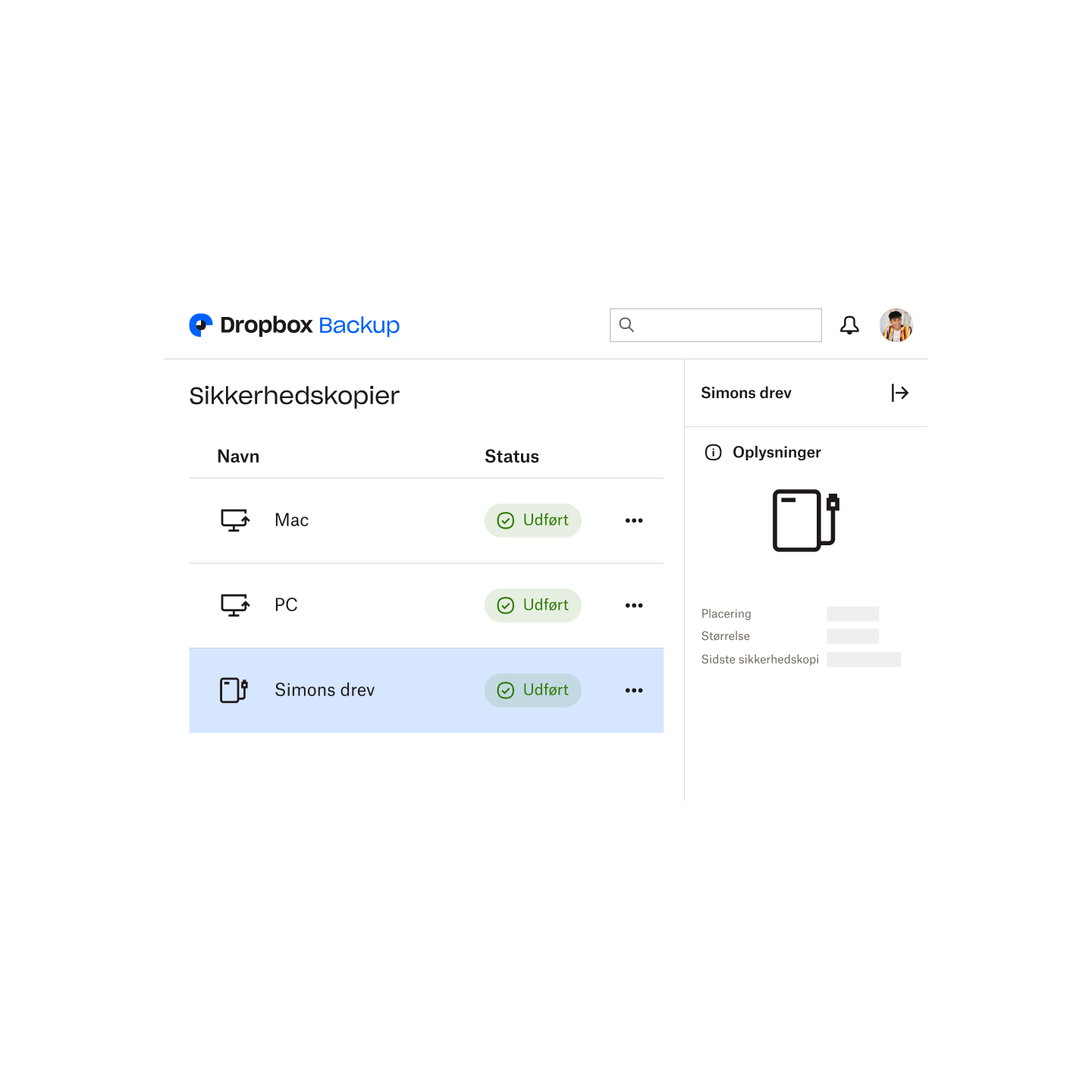For små virksomheder bør beskyttelse af data være en topprioritet. 3-2-1-databackupmetoden er ideel til at holde dine data sikre. Men hvad er 3-2-1 backup-strategien, og hvordan kan du bruge den i din virksomhed?
Det er vigtigt at beskytte dine data. Uanset hvilken fil det er – billede, video, dokument, regneark, database eller noget andet – er der altid en risiko for, at den kan blive slettet fra din computer for altid eller falde i de forkerte hænder ...
Det lyder måske lidt skræmmende, men hvis man tænker lidt over det, giver det god mening. Det er vigtigt at være forberedt på enhver form for datatab – og ikke kun den ondsindede slags. Omkring en fjerdedel af datasikkerhedsbrud skyldes menneskelige fejl.
Mange af os har nok ved et uheld slettet en vigtig fil eller kender frustrationen over en harddisk, der ikke fungerer. Uanset hvad årsagen er, er det ikke bare irriterende at miste filer, som du ikke kan få tilbage igen – det kan også være til stor skade for din virksomhed.
Derfor har du brug for en langsigtet plan for sikkerhedskopiering, for eksempel 3-2-1-strategien. Før vi forklarer, hvad 3-2-1-metoden til sikkerhedskopiering indebærer, så lad os lige hurtigt genopfriske, hvorfor det er så vigtigt for virksomheden at sikkerhedskopiere data.
For det første: Hvorfor er det vigtigt at have en databackupplan?
Alle skal have en plan for at beskytte deres data – uanset om det er personlige filer som familiefotos eller forretningsdokumenter som regneark og databaser.
Virksomheder er nødt til at vælge en strategi for sikkerhedskopiering. Der er ikke noget værre end at blive taget på sengen, hvis du mister vigtige data, fordi dine servere er nede, din bærbare computer er blevet stjålet, eller du mister data på anden vis.
Hvis du tror, du ikke er i risikozonen, så tro om igen. Ifølge Verizons undersøgende rapport om datasikkerhedsbrud fra 2024 var menneskelige fejl et element i 68 % af angrebene. Større virksomheder har sandsynligvis både budgettet og ressourcerne til at investere i omfattende cybersikkerhedsløsninger. Men som en lille virksomhed eller soloiværksætter kan det at opdage og forhindre angreb være op til kun nogle få afgørende parter – eller endda én enkelt person.
Uoprettelige datatab er ikke altid en total katastrofe, men du kan undgå det med en robust backupstrategi – f.eks. 3-2-1-metoden. Sikkerhedskopier beskytter dig mod cyberangreb og ransomware, menneskelige fejl som utilsigtet sletning af filer, naturkatastrofer som oversvømmelser og endda hardwarefejl.
Ved at oprette flere kopier af dine filer sikrer du, at din virksomhed hurtigt kan komme i gang igen, hvis noget går galt.

Hvad er "3-2-1-strategien"?
3-2-1-reglen er en måde at sikkerhedskopiere data på. Det hjælper dig med at få dine data hurtigt tilbage, hvis du mister dem.
Kort sagt involverer denne almindelige backupstrategi:
- Tre kopier af dine data
- To af disse kopier opbevares lokalt på forskellige lagerenheder, såsom din computers interne harddisk og bærbare lagermedier – f.eks. en ekstern harddisk.
- Én kopi af dataene opbevares eksternt i en løsning uden for virksomheden, f.eks. i en software til sikkerhedskopiering i skyen
Formålet med at implementere 3-2-1-backupstrategien er at mindske den potentielle indvirkning af et "enkelt fejlpunkt". Det betyder, at hvis en af dine enheder går ned og sletter én kopi af dine data, er det ikke verdens undergang – du har to alternativer, der kan redde dagen.
Hvorfor er det vigtigt at have både sikkerhedskopier på stedet og eksternt?
Onsite backup-metoder som flashdrev er praktiske. Hvis din computers harddisk går i stykker, eller du har problemer med internetforbindelsen, skal du bare tilslutte din backup-enhed – så får du dine data tilbage.
Onsite-backups kræver dog manuel indtastning – du skal huske at planlægge backupsene eller udføre dem selv. Det er også helt op til dig at holde dine onsite backups opdaterede.
Offsite backups i cloudløsninger som Dropbox Backup undgår dette problem, da det meste af processen kan automatiseres. En online backup beskytter også dine data mod de fysiske risici, der er forbundet med lokale backups, såsom tyveri og nedbrud af enheden – eller endda noget helt uforudsigeligt som en naturkatastrofe.
Cloud-backupløsninger giver dig også mulighed for at gøre mere med dine filer, såsom kontinuerlige "altid aktive" backups, der automatisk gemmer alle opdateringer, du foretager af de filer, du har gemt i systemet. Du kan også få adgang til dine sikkerhedskopierede filer når som helst og hvor som helst du har brug for dem – alt du behøver er en internetforbindelse.
Derfor kræver en holdbar backupstrategi både sikkerhedskopier internt og eksternt. Hvis du kun bruger én metode, kan du muligvis ikke genskabe dine filer så hurtigt eller nemt, som du har brug for – f.eks. hvis du uventet mister wi-fi-forbindelsen, eller din bærbare computer bliver stjålet.
Når du følger 3-2-1-metoden, kan du være sikker på, at dine data er sikre og kan gendannes, hvis noget går galt med en af dine sikkerhedskopier.

Hvad er "3-2-1-1-0-strategien"?
3-2-1-1-0-metoden bygger på 3-2-1-backup-reglen, men tager den et skridt videre. Ud over de tre kopier, der foreslås i 3-2-1-metoden, anbefaler denne strategi at oprette én ekstra offline- eller "air-gapped"-kopi af dine data.
Det vigtige ved denne kopi er, at den skal være fysisk adskilt fra de data, der sikkerhedskopieres. Det kan være bånd, der opbevares eksternt i en lagertjeneste, eller i cloudbaseret sikkerhedskopiering med uforanderlighed (hvilket betyder, at dataene ikke kan ændres).
Inden for din strategi skal du overvåge dine sikkerhedskopier (helst dagligt) for at sikre, at dine på stedet-/offline- og offsite-/på stedet-løsninger har nul fejl.
Hvad er "4-3-2-strategien"?
Denne strategi anvendes normalt til data, der administreres af tjenester til katastrofegendannelse. Det anbefales at oprette fire kopier af dine data, der gemmes tre forskellige steder.
Forskellen mellem denne og 3-2-1-metoden er, at to af placeringerne i en 4-3-2-strategi skal være eksternt. Dine kopier vil blive gemt geografisk adskilt fra hinanden og på forskellige netværk.
Disse eksterne kopier af dine data gemmes uforanderligt (hvilket betyder, at de ikke kan ændres) og har til formål at beskytte dem fuldstændigt mod naturkatastrofer og potentiel korruption.
Sådan implementerer du en 3-2-1-databackupstrategi
Hvis du er en lille virksomhed eller soloiværksætter, er 3-2-1-systemet til sikkerhedskopiering den ideelle metode til at sikre, at du hurtigt kan komme på fode igen, hvis noget går galt med dine data.
Det er vigtigt at overveje dine muligheder, før du implementerer din backupplan. Alle løsninger, du vælger – både onsite og offsite – bør være overkommelige, sikre og enkle. Det burde ikke være kompliceret at hente dine data!
Du bør også oprette en gendannelsesplan, så du og dit team ved, hvad I skal gøre med jeres sikkerhedskopier, hvis og når der opstår et datatab. Hvad er din ideelle genopretningstid, og hvordan vil hændelsen påvirke forretningskontinuiteten?
Det er bedre at handle tidligt end at være reaktiv, når noget sker.
Når du har dine forskellige medietyper og en ekstern placering, er det tid til at lave dine sikkerhedskopier. Start med at vælge de kopier, der skal opbevares eksternt, og dem, der skal sendes til skyen.
Det kan være en god idé at sikkerhedskopiere forskellige filer til forskellige placeringer. I så fald kan det være godt at opbevare filer, du jævnligt har brug for, i skyen. Med Dropbox Backup bliver alle ændringer, du foretager i dine filer, gemt automatisk – så behøver du ikke at planlægge manuel sikkerhedskopiering.
Indstil en backupplan for onsite backups, og sørg for, at alle fysiske backupmedier opbevares på et yderst sikkert sted. Test endelig dine sikkerhedskopier, før du lancerer din strategi på tværs af virksomheden eller teamet! Bare i tilfælde af.

Beskyt dit digitale liv med Dropbox Backup
Det burde ikke være en kompliceret proces at sørge for, at dine filer er sikre og nemme at genskabe. Med Dropbox får du effektive funktioner til filgendannelse og versionshistorik, så du nemt kan gendanne alle dine filer.
Med Dropbox Backup er det nemt at sikkerhedskopiere dine filer til skyen automatisk, så du hurtigt og ubesværet kan komme tilbage på sporet, uanset hvad der sker.


